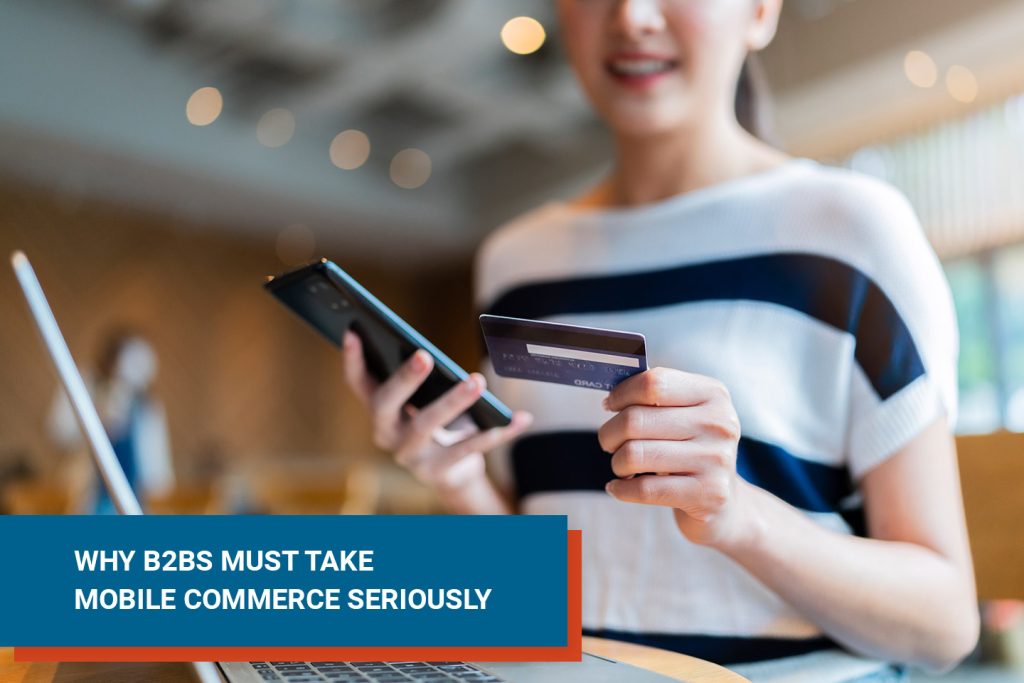Why B2Bs Must Take Mobile Commerce Seriously
 Igor Krasnykh
·
4 minute read
Igor Krasnykh
·
4 minute read

Table of Contents
- In 2017, half of B2B search queries were being made on smartphones. The number was expected to grow to 70% by 2020.
- Mobile influences an average of more than 40% of revenue in B2B organizations.
- More than 90% of B2B shoppers who have a positive mobile experience say they are more likely to buy from a vendor in the future.
- Today’s B2B customer does not want to interact with a salesperson until it’s time to close a sale.
Start with a B2B mobile game plan

If this article is hitting home for you, it’s time to sit down with your team and go to the drawing board. There are several mobile commerce options to consider.
Will you finally make a fully responsive website that displays correctly on all devices and screen sizes? While some B2Bs adopted responsive web design long ago, others are just dipping their toes in the water. If that’s where you are, it’s okay. Adopting a responsive template for your website is a great place to start. It is also a step you should not put off any longer.
If you have already mastered responsive design for your eCommerce business, perhaps it is time to take your efforts a step further with a mobile-first design. That means the design of your website begins on mobile, and then features are expanded to accommodate tablets and desktops. Because mobile design has more restrictions, this strategy is more effective than creating a desktop-first website that has to be dumbed down for mobile use.
If you’re really serious and have the resources to do so, consider creating a full-fledged mobile commerce app. Mobile users are used to receiving push notifications from apps, so why not add yours to the mix? This is a good way to keep your brand top-of-mind while enhancing customer service. You can remind customers that it’s time to reorder or that their payment is about to be processed.
Releasing a mobile commerce app to the public is also a good opportunity to create a buzz about your expanded digital offerings. Once the app is live, promote it on your social channels and send out a media release. (It wouldn’t be as exciting to share news about your company moving to a responsive template. If anything, it would highlight that you are behind the curve).
Progressive web applications (PWAs) are another option for B2Bs seeking a mobile-savvy presence. PWAs look and function like smartphone applications, however, they are accessed through a mobile browser. This eliminates the need to download a separate mobile app while still providing benefits like a sleek look and fast load times.
Regardless of which mobile commerce approach you take, special consideration should be given to the checkout process. Time-consuming payment processes create a bottleneck for mobile buyers. At best, they will complete the purchase and never return again. At worst, they will abandon their shopping cart (still never to return again). You want your shoppers to cross the finish line, and research shows that providing an instant purchase option helps take them there.
Choosing the right B2B platform is essential for mobile commerce success

As mobile buying flourishes, it’s more important than ever to choose an eCommerce platform that checks all the necessary boxes. That’s why more B2B merchants are launching their virtual storefronts on the Magento eCommerce platform. Magento is owned by Adobe, a well-known future-driven technology company.
In 2018, Magento beefed up its mobile capabilities with the release of the Magento PWA Studio. The software supports headless commerce that eliminates design constraints and enables look-and-feel changes in real-time. Magento also has a large library of out-of-the-box mobile-friendly templates to choose from.
Ensuring your eCommerce platform is compatible with popular payment gateways is also essential for closing mobile sales. Magento offers seamless integrations with PayPal, Braintree, and other common digital wallets. Tools like Magento’s Instant Purchase button also allow shoppers to bypass redundant checkout steps by leveraging a shopper’s stored payment and shipping information.
If you are an online merchant who would like to learn more about tapping into the power of Magento’s mobile capabilities, we are here to help. Schedule time on our calendar for a complimentary one-on-one strategy call with one of our Magento experts.



